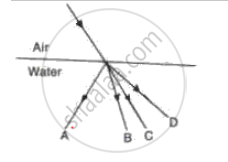Advertisements
Advertisements
प्रश्न
The diagram shows the path of a ray of light through a rectangular glass block placed in a liquid of uniform density.

What is the angular, deviation of the emergent ray from the glass block with respect to the incident ray?
उत्तर
As shown by the line in the diagram, the emergent ray is parallel to the incident ray (when produced) and so there is no angular deviation.
APPEARS IN
संबंधित प्रश्न
Which of the above wavelengths has a higher frequency?
A ray of light passes from glass into air. The angle of refraction will be:
(a) equal to the angle of incidence
(b) greater than the angle of incidence
(c) smaller than the angle of incidence
(d) 45°
A light ray in passing from water to a medium
(a) speeds up
(b) slows down. In each case, give one example of the medium.
A ray of light passes from air to water. In fig. 39, which of the ray A, B, C and D is the correct refracted ray?

Name the phenomenon responsible in the following case:
Apparent bending of a stick in water
Name the material for which the refractive index is found to be maximum.
In what condition a prism is said to be in the position of minimum deviation? What is the direction of the refracted ray inside the prism in this condition?
Trace a ray of light incident at 30° on a surface if travelling from glass to air. What is the angle of refraction in this case? (R.I. for glass = 3/2).
A coin placed at the bottom of a beaker appears to be raised by 4.0 cm. If the refractive index of water is 4/3, find the depth of the water in the beaker.
Draw the ray diagram of a glass slab having medium A and B for the velocity of light ray VA and VB respectively and define Snell's law.
- If VB = 1.5 VA, then which medium is denser?
- What is the refractive index of A with respect to B?
- What is the refractive index of B with respect to A?
